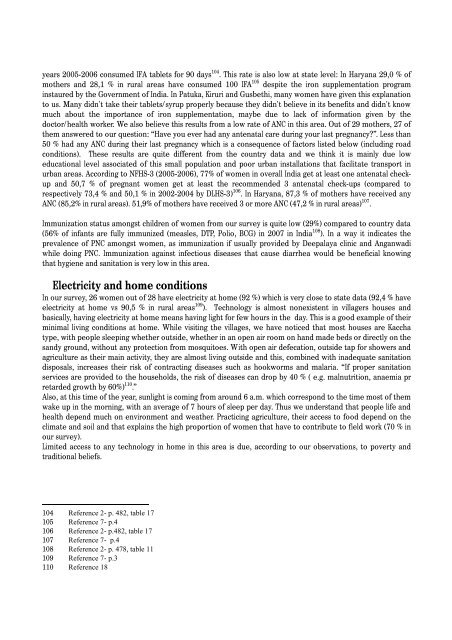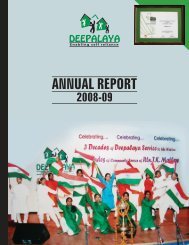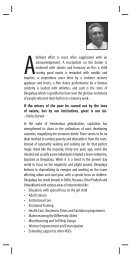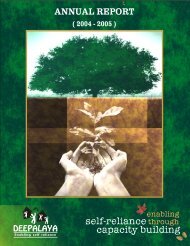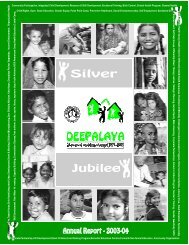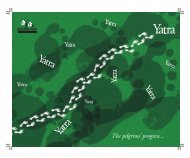Report 2011 - Deepalaya
Report 2011 - Deepalaya
Report 2011 - Deepalaya
Create successful ePaper yourself
Turn your PDF publications into a flip-book with our unique Google optimized e-Paper software.
years 2005-2006 consumed IFA tablets for 90 days 104 . This rate is also low at state level: In Haryana 29,0 % of<br />
mothers and 28,1 % in rural areas have consumed 100 IFA 105 despite the iron supplementation program<br />
instaured by the Government of India. In Patuka, Kiruri and Gusbethi, many women have given this explanation<br />
to us. Many didn't take their tablets/syrup properly because they didn't believe in its benefits and didn't know<br />
much about the importance of iron supplementation, maybe due to lack of information given by the<br />
doctor/health worker. We also believe this results from a low rate of ANC in this area. Out of 29 mothers, 27 of<br />
them answered to our question: “Have you ever had any antenatal care during your last pregnancy”. Less than<br />
50 % had any ANC during their last pregnancy which is a consequence of factors listed below (including road<br />
conditions). These results are quite different from the country data and we think it is mainly due low<br />
educational level associated of this small population and poor urban installations that facilitate transport in<br />
urban areas. According to NFHS-3 (2005-2006), 77% of women in overall India get at least one antenatal checkup<br />
and 50,7 % of pregnant women get at least the recommended 3 antenatal check-ups (compared to<br />
respectively 73,4 % and 50,1 % in 2002-2004 by DLHS-3) 106 . In Haryana, 87,3 % of mothers have received any<br />
ANC (85,2% in rural areas). 51,9% of mothers have received 3 or more ANC (47,2 % in rural areas) 107 .<br />
Immunization status amongst children of women from our survey is quite low (29%) compared to country data<br />
(56% of infants are fully immunized (measles, DTP, Polio, BCG) in 2007 in India 108 ). In a way it indicates the<br />
prevalence of PNC amongst women, as immunization if usually provided by <strong>Deepalaya</strong> clinic and Anganwadi<br />
while doing PNC. Immunization against infectious diseases that cause diarrhea would be beneficial knowing<br />
that hygiene and sanitation is very low in this area.<br />
Electricity and home conditions<br />
In our survey, 26 women out of 28 have electricity at home (92 %) which is very close to state data (92,4 % have<br />
electricity at home vs 90,5 % in rural areas 109 ). Technology is almost nonexistent in villagers houses and<br />
basically, having electricity at home means having light for few hours in the day. This is a good example of their<br />
minimal living conditions at home. While visiting the villages, we have noticed that most houses are Kaccha<br />
type, with people sleeping whether outside, whether in an open air room on hand made beds or directly on the<br />
sandy ground, without any protection from mosquitoes. With open air defecation, outside tap for showers and<br />
agriculture as their main activity, they are almost living outside and this, combined with inadequate sanitation<br />
disposals, increases their risk of contracting diseases such as hookworms and malaria. “If proper sanitation<br />
services are provided to the households, the risk of diseases can drop by 40 % ( e.g. malnutrition, anaemia pr<br />
retarded growth by 60%) 110 .”<br />
Also, at this time of the year, sunlight is coming from around 6 a.m. which correspond to the time most of them<br />
wake up in the morning, with an average of 7 hours of sleep per day. Thus we understand that people life and<br />
health depend much on environment and weather. Practicing agriculture, their access to food depend on the<br />
climate and soil and that explains the high proportion of women that have to contribute to field work (70 % in<br />
our survey).<br />
Limited access to any technology in home in this area is due, according to our observations, to poverty and<br />
traditional beliefs.<br />
104 Reference 2 - p . 4 8 2 , t a b l e 1 7<br />
105 Reference 7 - p . 4<br />
106 Reference 2 - p . 4 8 2 , t a b l e 1 7<br />
107 Reference 7 - p.4<br />
108 Reference 2 - p. 478, table 11<br />
109 Reference 7 - p . 3<br />
110 R e f e r e n c e 1 8


